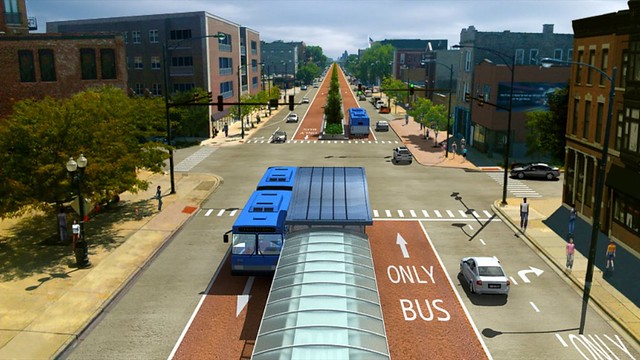Aaron Renn, a senior fellow at the Manhattan Institute and a contributing editor at City Journal, writes the popular blog The Urbanophile, and sometimes his articles are right on the money. For example Streetblog NYC reporter Stephen Miller tells me Renn was justified in complaining about the high cost of New York infrastructure projects in a Daily News op-ed earlier this year.
However, the Chicago-centric piece that Renn published today in the urban planning site NewGeography.com, cofounded by pro-sprawl guru Joel Kotkin, is a real doozy. He argues that our city’s Ashland Bus Rapid Transit project is example of wrongheaded one-size-fits-all thinking by car-hating urbanists that’s about "actively making things worse for drivers.”
Renn, a former Chicagoan, actually makes some good points about the benefits of transit-oriented development and protected bike lanes in the article. I even agree with his assertion that, for many residents, the fact that Chicago offers numerous sustainable transportation options, as well as the ability to own, drive and park a car relatively cheaply and conveniently, represents “the best of both worlds.” He argues that, along with more affordable housing prices, the fact that it’s easy to live with or without with a car in Chicago is one of its main advantages over peer cities like New York, San Francisco, and Boston.
However, the article goes south when the author, who currently lives in Manhattan, argues that big-box stores with vast parking moats are one of Chicago’s finest features. He tells a harrowing tale of trying to whip up a batch of artisanal mayonnaise, only to discover that his local grocery store in the Upper West Side didn’t stock the right kind of olive oil.
"I can assure you in my old place in Chicago, one quick trip to Jewel or any of the other plentiful supermarkets would have taken care of that," he writes. "Stores like that, or like Sam’s Wine and Spirits and host of others, only exist because they are able to draw from a trade area served by the car, and because people can buy large quantities best transported by car."
A more serious problem with Renn’s piece is his assertion that the Ashland BRT project would be a case of transit advocates intentionally “degrading the urban environment” for drivers, which would make Chicago a less livable city. The plan calls for converting two of the four travel lanes on Ashland Avenue to dedicated, center-running bus lanes, which would require the elimination of most left turns off of the street.
“Fortunately, this [project] appears to be dying on the vine in the face of neighbor opposition,” he writes, linking to a Sun-Times article about the city’s recent announcement that express bus service is returning to Ashland and Western Avenue. Although that piece was titled “Ashland BRT Seems All But Dead With Return of Ashland, Western Express Buses,” its report of the BRT route’s demise was greatly exaggerated, as Mark Twain might say. A CTA insider tells us that some agency staffers view the new limited-stop service with bus-priority stoplights as a step towards full-fledged BRT.
“Where Ashland Ave. BRT fails is not in its attempt to improve transit service or to accommodate those who choose not to have cars,” Renn writes. “Rather, the problem is that it is rooted in a vision… that believes car use should be deliberately discouraged and minimized – ideally eliminated entirely – in the city.”
There are a couple of problems with these statements. The Chicagoans who have the most to gain from the Ashland BRT are those are carless by necessity, not by choice. Ashland is the city's busiest bus line. Roughly 25 percent of household within a half mile of the 16-mile BRT route don’t own cars, and many of the neighborhoods it would serve are low-to-moderate income communities on the South Side.
Dedicated lanes and prepaid, level boarding from median stations, plus other timesaving features, would roughly double bus speeds, from the current 8.7 mph to 15.9 mph. That would make it much easier for carless Chicagoans, including many low-income people, to access work, school, and medical appointments. The project would also include wider sidewalks and easier pedestrian crossings. These are some of the reasons why the project is endorsed by dozens of local community organizations and businesses, as well as more than 1,800 residents who signed an Active Transportation Alliance petition in favor of the plan.
Moreover, reconfiguring the street would not cause major hardships for drivers. The CTA projects that average car traffic speeds on Ashland would only be slightly reduced, from 18.3 to 16.5 mph. And the left-turn prohibition wouldn’t be a major imposition on motorists. Delivery companies like UPS already plan their routes to avoid lefts, in order to save time and fuel.
“The no-car philosophy as the norm, not just an option, would undermine one of the greatest strategic advantages of Chicago,” Renn argues. In doing so, he ignores the fact that the vast majority of the city’s 4,000-plus miles of streets were designed with an overwhelmingly pro-car philosophy. Leveling the playing field for transit riders and pedestrians on 16 miles of roadway certainly isn’t going to do much to make the city less appealing for people who choose to drive.







